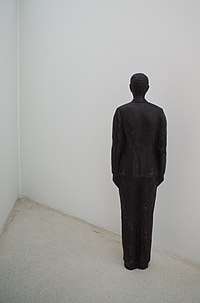Philip Aguirre y Otegui

Philip Aguirre y Otegui (1961-) is a Belgian artist who mainly works as a sculptor and painter. His work usually centers around migration and refugees,[1], water, and the shelter of architecture.[2]
Biography
Philip Aguirre is born in Schoten in 1961. His father Juan Martin Aguirre originally came from Las Arenas, in Spanish Basque Country, but moved as a child to Antwerp, Belgium in 1936, when the Spanish Civil War started. His mother's family suffered under the German occupation and the persecution of Jews in Belgium during the second World War.[2] Aguirre studied in Antwerp and now lives in Borgerhout.[3][4]
In 2017 he won the International Award for Public Art for his 2010 installation Théatre Source in Douala, Cameroon.[5] In 2015 a 45-minute documentary with a voice-over by Jan Decleir, about the making of this work was created by cineast Koen Van den Bril. It showed how a muddy well was transformed in 9 months time into a meeting place for a village. Art publisher Ludion also made a book about the installation.[4]
His work is influenced by Frans Masereel (for the humanistic vision and the effort to bring art to the people), the sculptors Constantin Brancusi and Alberto Giacometti, photographer Manuel Alvarez Bravo, and contemporary Belgian artist Francis Alÿs.[2]
He is a nephew of TV presenter Phara de Aguirre.[3]
Major works
- 1996: Fountain, Koolkaai, Antwerp
- 2001 The carrier of the mattress, concrete sculpture in Brussels Airport
- 2009: Gaalgui, wooden sculpture, Nieuwpoort
- 2010-2013: Théatre Source, a monumental work with a well and a staircase, in Douala, Cameroon
- 2016: Cabinet Mare Nostrum, painting
- 2016: Still (the) Barbarians, installation
- 15 August 1942, Lange Kievitstraat, Antwerpen, sculpture in the Kazerne Dossin – Memorial about the first razzia against Jews in Belgium
- Fallen dictator
- Karel van Miert, a 5 metre high sculpture in Oud-Turnhout
- The man of Flanders, City hall, Kaprijke
- Water sculpture, Provinciehuis, Antwerp
- Water carrier, bronze, University of Antwerp. Also exists in beeswax.
Major solo exhibitions
- 2008: Middelheim Open Air Sculpture Museum, Antwerp[2]
- 2013: Mu.ZEE, Ostend[2]
Bibliography
- Sculptures, an overview of his sculptural work from 1985 until 2007
Notes
- ↑ Elderton, Louisa (30 November 2016). "Migration // The Need for Solidarity: An Interview with Philip Aguirre y Otegui". BerlinArtLink. Retrieved 24 August 2018.
- 1 2 3 4 5 Bracke, Erik. "Olie drijft boven: het humanistisch oeuvre van Philip Aguirre y Otagui" (PDF). Ons Erfdeel (in Dutch). 2014 (1): 32–39.
- 1 2 Van Puymbroeck, Rik (2017). "Philip Aguirre y Otegui". Ergens onderweg: gesprekken met inspirerende mensen (in Dutch). VBK - Houtekiet. ISBN 9789089245878.
- 1 2 Anrys, Stefaan (16 March 2015). "Théâtre Source: kan kunst de wereld redden?". Mo (in Dutch).
- ↑ Van Houten Maldonado, Devon (28 April 2017). "An International Exhibition Imagines an Intersectional Future". Hyperallergic. Retrieved 24 August 2018.